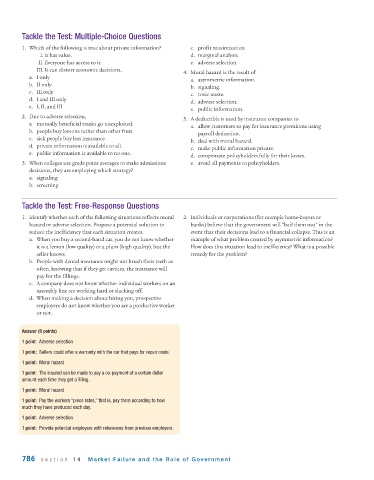Page 828 - Krugmans Economics for AP Text Book_Neat
P. 828
Tackle the Test: Multiple-Choice Questions
1. Which of the following is true about private information? c. profit maximization
I. It has value. d. marginal analysis
II. Everyone has access to it. e. adverse selection
III. It can distort economic decisions.
4. Moral hazard is the result of
a. I only
a. asymmetric information.
b. II only
b. signaling.
c. III only
c. toxic waste.
d. I and III only
d. adverse selection.
e. I, II, and III
e. public information.
2. Due to adverse selection,
5. A deductible is used by insurance companies to
a mutually beneficial trades go unexploited.
a. allow customers to pay for insurance premiums using
b. people buy lemons rather than other fruit.
payroll deduction.
c. sick people buy less insurance.
b. deal with moral hazard.
d. private information is available to all.
c. make public information private.
e. public information is available to no one.
d. compensate policyholders fully for their losses.
3. When colleges use grade point averages to make admissions e. avoid all payments to policyholders.
decisions, they are employing which strategy?
a. signaling
b. screening
Tackle the Test: Free-Response Questions
1. Identify whether each of the following situations reflects moral 2. Individuals or corporations (for example home-buyers or
hazard or adverse selection. Propose a potential solution to banks) believe that the government will “bail them out” in the
reduce the inefficiency that each situation creates. event that their decisions lead to a financial collapse. This is an
a. When you buy a second-hand car, you do not know whether example of what problem created by asymmetric information?
it is a lemon (low quality) or a plum (high quality), but the How does this situation lead to inefficiency? What is a possible
seller knows. remedy for the problem?
b. People with dental insurance might not brush their teeth as
often, knowing that if they get cavities, the insurance will
pay for the fillings.
c. A company does not know whether individual workers on an
assembly line are working hard or slacking off.
d. When making a decision about hiring you, prospective
employers do not know whether you are a productive worker
or not.
Answer (8 points)
1 point: Adverse selection
1 point: Sellers could offer a warranty with the car that pays for repair costs.
1 point: Moral hazard
1 point: The insured can be made to pay a co-payment of a certain dollar
amount each time they get a filling.
1 point: Moral hazard
1 point: Pay the workers “piece rates,” that is, pay them according to how
much they have produced each day.
1 point: Adverse selection
1 point: Provide potential employers with references from previous employers.
786 section 14 Market Failure and the Role of Gover nment

